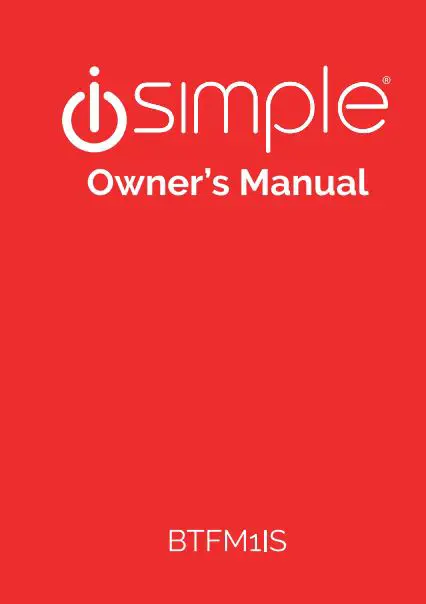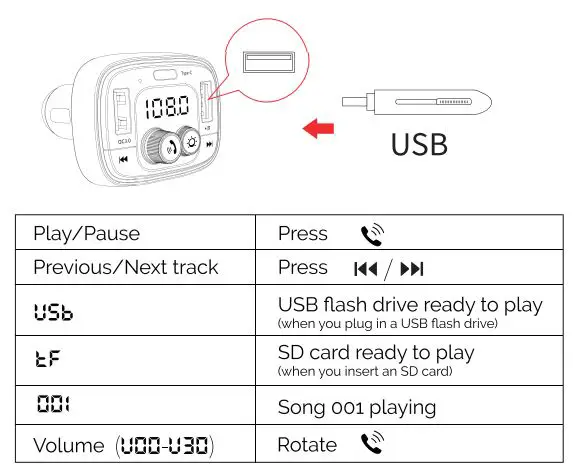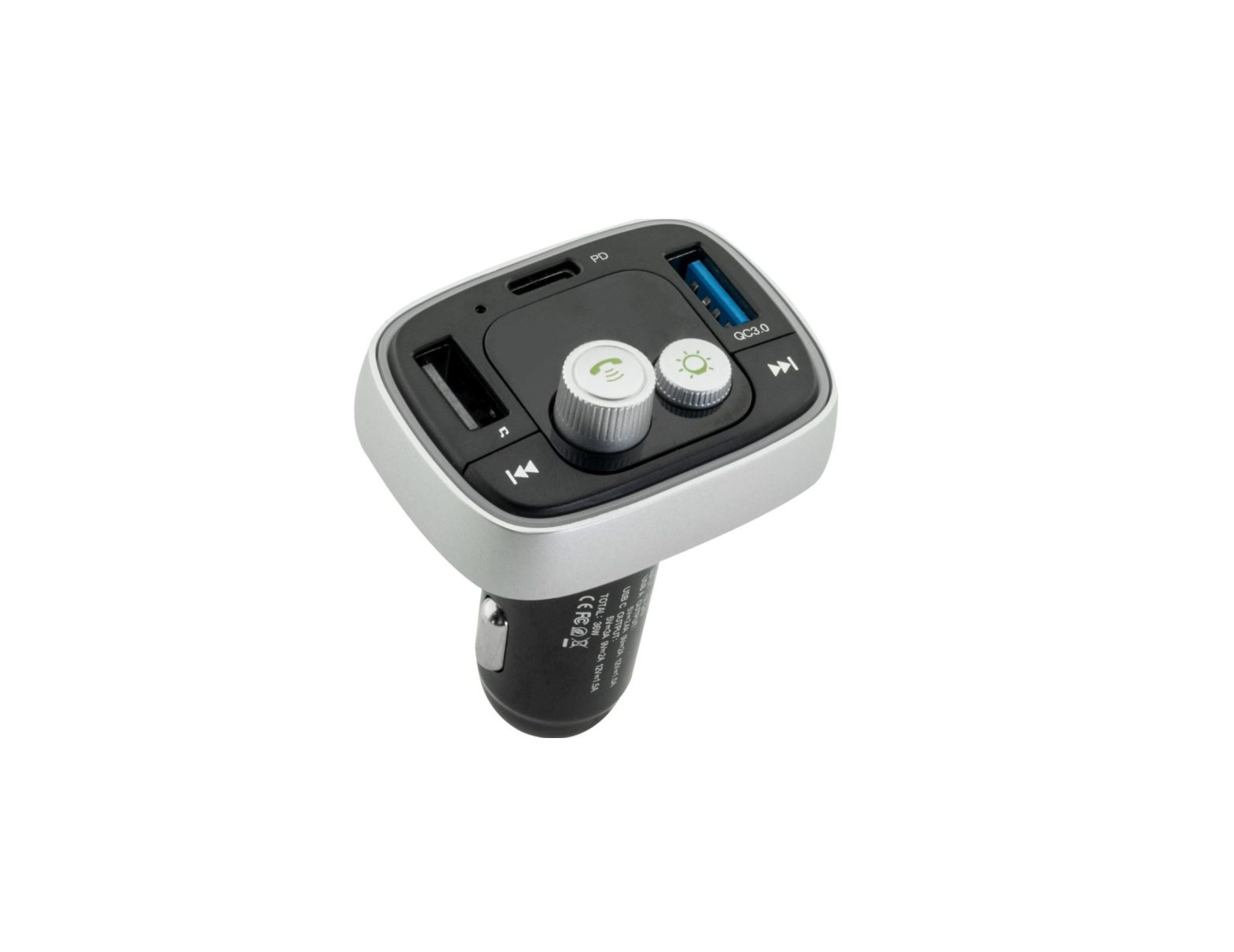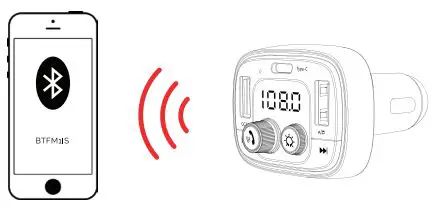simple BTFM1IS Vehicle Bluetooth 5.0 FM Transmitter Owner's Manual

Safety Instructions
- Please read this manual carefully before using
- Keep these instructions
- Do not disassemble
- Do not expose directly to sunlight or open flame
- Pay attention to the road and do not operate this product while driving
Introduction
Features:
- Input 12-24V
- FM transmitter: 88.1-1079 MHz frequency range
- Bluetooth hands-free calling
- Stream music from smartphone to car system via FM transmission
- USB 1: 5V/2,4A with intelligent input current management
- Type-C: PD 18Wwith PPS
- Support USB flash drive playing
- Support TF card playing
- Supports playing from SD cards
- Car battery monitor
BTFM1IS

- Type-C charging port
- LED display
- Microphone
- Previous song
- Next song
- USB1 charging port
- USB2 flash drive reading & playing port
- SD card slot
- Multifunction knob button: change frequency; volume +/- ; answer & hang up calls
- LED light control

Get it Ready for Playing
- Plug BTFM1IS into your car cigarette lighter socket.

- LED display light will turn on and show ‘13.5- bt-1079
- Connecting Bluetooth: When LED display reads “Bt,” it is in pairing mode, and voice prompt will say “Waiting for connection.”
On your smartphone, enable Bluetooth function, search for available devices, select “BTFM1IS,” and pair with it. Once connected, listen for voice prompt “Bluetooth connection success.” You are now paired.

- Turn on your car’s FM radio and find an empty (only static) channel. Then, adjust the frequency on BTFM1IS to match the frequency of your car radio.

- Adjusting FM transmitter frequency: Press and hold multifunction knob button until frequency display starts blinking; rotate dial to adjust FM transmitting frequency to match car radio frequency.
Play Music
Playing music from your phone:
After steps 1-5, you can start playing audio using your smartphone. The music will stream via the Bluetooth A2DP function; your phone’s FM transmission will travel to your car radio and through your car’s speakers.

Playing music from USB flash drive:
Plug USB flash drive into the USB port on the right side with the “QC3.o” icon. BTFM1IS will start playing automatically.

Play music from SD card:
Insert SD card into SD card slot. BTFM1IS will recognize it by displaying “l::F” and start playing automatically. Follow same directions as USB flash drive playing mode ..

How to switch playing modes.
Press “►►I” and hold until LED displays BT or SD (or USB), playing mode will switch.
EO Switch Quick ButtonThe EO quick button can be used to switch sound quality from standard (Eqo) to Bass (Eq1) with a short press. Press it again to switch back to standard (Eqo).
Hands-Free Call
After you set up playing, you can also use the hands-free function.

Under music playing status (BT/SD/USB flash drive), if there is a call coming in, it will switch to call mode automatically. After hanging up, it will switch back to playing mode automatically.
Charge Your Device
BTFM1IS Bluetooth FM transmitter has one Type-C port and two USB ports, with a total max 36A output in intelligent current sharing mode:

This port is used for changing low current devices. Mainly it is used for USB flash drive playing.
Specifications
DC input: 12V-24VOutput: Type C PD3.0 18W for iPhoneBluetooth V5.0Bluetooth connect distance: 10mAudio format: MP3, WMA, FLAC, WAVFM transmitting distance: ≥ 2mUSB capacity support: ≤ 64GbWorking temperature range: -20·c to 40·cStorage temperature range: -40·c to 75·c
NOTE: This equipment has been tested and found to comply with the limits for a Class B digital device, pursuant to part 15 of the FCC Rules. These limits are designed to provide reasonable protection against harmful interference in a residential installation. This equipment generates uses and can radiate radio frequency energy and, if not installed and used in accordance with the instructions, may cause harmful interference to radio communications. However, there is no guarantee that interference will not occur in a particular installation. If this equipment does cause harmful interference to radio or television reception, this can be determined by turning the equipment off and on. The user is encouraged to try to correct the interference by one more of the following measures:
– Reorient or relocate the receiving antenna– Increase the separation between the equipment and receiver.– Connect the equipment into an outlet on a circuit different from that to which the receiver is connected.– Consult the dealer or an experienced radio/TV technician for help.
Changes or modifications not expressly approved by the party responsible for compliance could void the user’s authority to operate the equipment.This device complies with Part 15 of the FCC Rules. Operation is subject to the following two conditions:(1) this device may not cause harmful interference, and(2) this device must accept any interference received, including interference that may cause undesired operation.
[xyz-ips snippet=”download-snippet”]



